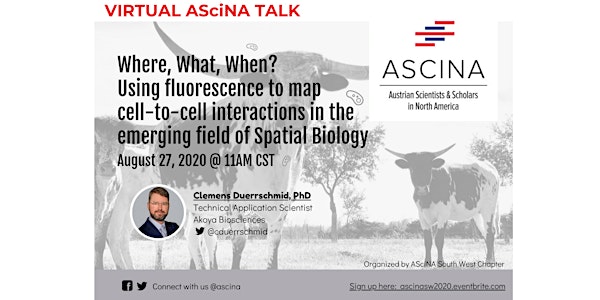
Spatial Biology: using fluorescence to map cell-cell interactions
Ascina 2020
Date and time
Location
Online
About this event
**You can find the Zoom link under Additional Information in your confirmation email.
Where, What, When? Using fluorescence to map cell-to-cell interactions in the emerging field of Spatial Biology
Clemens Duerrschmid, PhD
Technical Application Scientist
Akoya Biosciences
Dr. Duerrschmid will speak about his academic work in cardiovascular immunology and his current role at Akoya Biosciences. Akoya Biosciences offers multiplex immunofluorescence solutions to detect up to 40 biomarkers on intact tissue sections. This approach allows researchers to interrogate cells within their spatial context, in turn enabling improved patient stratification in preclinical trials, in immuno-oncology, neuroscience, transplant biology, infectious diseases, and beyond.
Clemens received both his Master’s Degree and Doctoral Degree from the University of Natural Resources and Life Sciences, Vienna (BOKU). During his doctoral studies, he joined the Entman lab at Baylor College of Medicine (Houston, TX) as a visiting fellow, where he studied the transition from predominantly inflammation-promoting macrophages towards inflammation-resolving ones in chronic heart disease.
In 2015, Clemens joined the lab of Dr. Atul Chopra, first at Baylor college of Medicine and later, when the lab moved, at Case Western Reserve University, where he worked on a novel metabolic hormone called Asprosin. Since the beginning of 2020, Clemens has been a Technical Application Scientist at Akoya Biosciences, where he provides solutions for researchers interested in analyzing multiple biomarkers on a single piece of tissue, and learning more about the spatial interplay of cells in healthy and diseased tissues.